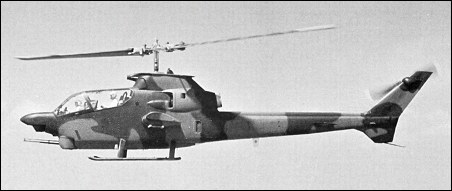
| Bell Model 309 Kingcobra 2002 - project |  |
 |

| Bell Model 309 Kingcobra 2002 - project |  |
 |
|
Having always regarded the Model 209 as a temporary solution until a higher-performance machine was available, Bell decided to press ahead with a new project for the American armed forces and on 28 September 1971 announced the development of a new combat helicopter which flew on 10 September 1971. This was the Model 309 Kingcobra, clearly derived from the Model 209, with a 1.10m longer, more robust fuselage supporting a larger diameter rotor measuring 14.63m. Both the main and tail rotors had wider chord blades and the blades of the former had double swept tips to reduce noise levels and improve performance at high speed. The nose was also modified to accept new apparatus, the available space for ammunition was increased and the wing span was taken to 3.96m. Of the two prototypes built, the first was offered to the Marines in the usual configuration with Turbo Twin Pack T400 engines, while the second prototype (which flew in January 1972) was offered to the Army with a different powerplant — the 2890shp Lycoming T55-L7C turbine, derated to 2050 on take-off. On 11 April 1972, the first prototype was damaged in an accident. The second took part in comparative trials with the Lockheed Cheyenne and Sikorsky S-67 Blackhawk, but the US Army decided that none of them matched its requirements. The Kingcobra was a highly sophisticated aircraft with the latest equipment including an automatic stabilization system, autotrim system, laser day and night sight, infrared fire control system, night vision TV and an inertial navigation system. From the Model 309, Bell derived a new prototype attack helicopter, the Model 409 (US Army designation YAH-63), which it entered for the AAH (Advanced Attack Helicopter) competition won by the aircraft proposed by Hughes. The YAH-63 had a different profile from the Kingcobra, including a conspicuous ventral fin and a tail plane at the top of the tail fin. G.Apostolo "The Illustrated Encyclopedia of Helicopters", 1984 Late in 1969, with the US disengagement from Vietnam, the US Army began to be more concerned by the military balance in central Europe. The huge number of tanks deployed by the Warsaw Pact land forces was its prime matter of concern. An attack helicopter with tank-killing capability was considered a high priority. At the time, the Lockheed AH-56A Cheyenne, developed under AAFSS and flown in May 1967, had such a capability but its cost, complexity and teething troubles greatly handicapped its future. The ideal weapon system appeared then to be a combination of the AH-1 Cobra helicopter and the anti-tank TOW missile. Bell decided to build, with company funds, two prototypes of such an aircraft, both in single-engined and twin-engined configurations, known as the Model 309 KingCobra. Design work was begun by a team led by Joe Tilley and construction started in January 1971. The Model 309 was a scaled-up version of the AH-1G with a gross weight of 6350kg, a lengthened and stiffened fuselage, a redesigned tail assembly with lower fin for improved longitudinal stability and a considerably modified nose. It also had the transmission, wide-chord two-blade main rotor and drive train of the Model 211 HueyTug. The single-engine prototype retained the 2.850shp Avco-Lycoming T55-L-7C turboshaft engine of the Model 211 while the twin-engined prototype had the 1.800shp Pratt & Whitney T400-CP-400 turboshaft TwinPac powerplant. The KingCobra incorporated new avionics and systems to fulfill its anti-tank mission (inertial navigation system, APN-198 radar altimeter, fire-control computer, multi-sensor sight, head-up display, helmet sighting system, FL-33 FLIR, low-light level television and, of course TOW guidance system). Armament included provision for sixteen TOW missiles under extended stub wings and a General Electric chin-turret housing a three-barelled 20mm Gatling gun with 1.345 rounds. The twin-engined Model 309 (c/n 2503, registered N309J) made its maiden flight at Fort Worth on 10 September, 1971, with Gene Colvin at the controls, followed by its single-engined stable mate in January 1972. Unfortunately, the latter was the victim of an accident on 11 April, 1972, and suffered major damage. To meet future Army needs it was decided to convert the twin-engined 309 into single-engined configuration. As expected, on 9 August, 1972, the Army finally cancelled the Cheyenne programme and in due course two helicopter manufacturers, Sikorsky and Bell, submitted proposals for a less sophisticated aircraft, the Model S-67 and the Model 309 respectively. Tests and demonstrations were successfully conducted with both aircraft, but the Army set up new requirements and opened a new contest within the Advanced Attack Helicopter programme (AAH) which would eventually lead to the selection of today's MDD/Hughes AH-64 Apache. The Bell Model 309 (N309J) is now preserved by the US Army Aviation Museum in Fort Rucker, Alabama. A.J.Pelletier "Bell Aircraft since 1935", 1992 * * *
|